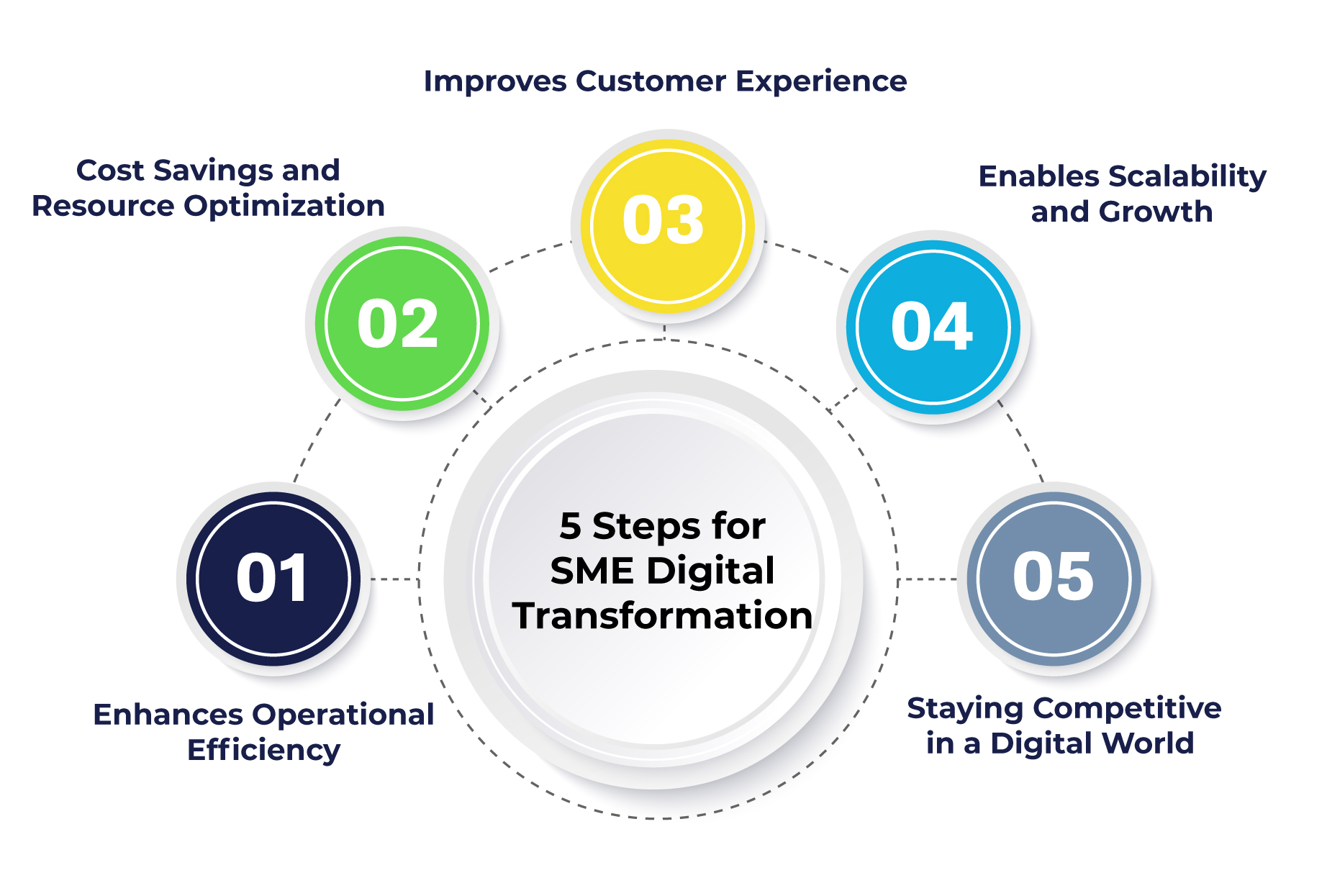Digital Transformation Strategies for SMEs
Introduction
In today’s competitive business environment, digital transformation is no longer a luxury but a necessity for small and medium-sized enterprises (SMEs) looking to stay relevant and competitive. Digital transformation empowers businesses to leverage modern technologies to streamline processes, enhance customer experiences, and drive growth. At i4 Tech Integrated Services, we specialize in helping SMEs adopt digital solutions that optimize their operations, increase efficiency, and foster innovation. In this article, we’ll explore key digital transformation strategies that can drive success for SMEs.
1. Start with a Clear Digital Strategy
Before diving into digital transformation, it’s essential for SMEs to develop a clear and comprehensive digital strategy that aligns with business goals. This strategy should outline the following:
- Business Objectives – Identify specific business goals you want to achieve through digital transformation, such as improving customer experience, increasing operational efficiency, or expanding market reach.
- Technology Needs – Assess the technologies you need to implement to meet your goals. This could include cloud solutions, customer relationship management (CRM) systems, or automation tools.
- Budget & Timeline – Allocate resources for the transformation process, including setting realistic budgets and timelines for implementing digital tools.
2. Embrace Cloud Computing
Cloud computing offers SMEs a flexible, scalable, and cost-effective solution to manage operations without the need for heavy infrastructure investments. Cloud-based solutions enable businesses to:
- Improve Collaboration – Cloud tools allow teams to collaborate in real-time, access files, and share information easily, regardless of their location.
- Scale Operations – As your business grows, cloud solutions can scale with you, providing the necessary resources to handle increased demands without overburdening your IT infrastructure.
- Enhance Security – Leading cloud providers offer robust security features, such as data encryption, automatic backups, and disaster recovery options, to ensure business continuity and data protection.
3. Implement Automation to Improve Efficiency
Automation is a critical part of digital transformation, helping SMEs save time, reduce errors, and optimize workflows. Key areas where automation can drive value include:
- Business Process Automation (BPA) – Automating routine tasks such as invoicing, payroll, and inventory management frees up valuable time for employees to focus on higher-value tasks.
- Customer Support Automation – AI-powered chatbots and automated ticketing systems provide 24/7 customer support, improving response times and customer satisfaction.
- Marketing Automation – Tools like email marketing automation can help SMEs deliver personalized content to customers and prospects at the right time, improving lead conversion and customer retention.
4. Leverage Data Analytics for Better Decision-Making
Data-driven decision-making is essential for SMEs to gain a competitive edge. With the right tools, businesses can collect and analyze valuable data that helps inform strategies and improve operational outcomes. Key benefits include:
- Customer Insights – By analyzing customer data, businesses can uncover valuable insights about purchasing behavior, preferences, and trends, enabling them to offer personalized products and services.
- Performance Monitoring – Data analytics allows businesses to track key performance indicators (KPIs) such as sales, revenue, and productivity, helping to identify areas for improvement.
- Predictive Analytics – With advanced analytics tools, SMEs can forecast market trends, demand patterns, and potential risks, allowing for proactive decision-making.
5. Strengthen Cybersecurity Measures
As SMEs adopt more digital tools, they become more vulnerable to cyber threats. A strong cybersecurity strategy is crucial for protecting sensitive data, maintaining customer trust, and complying with industry regulations. Key cybersecurity strategies include:
- Employee Training – Educate employees on the latest cyber threats, such as phishing attacks, and encourage safe online practices.
- Data Encryption – Ensure that all sensitive data is encrypted both in transit and at rest to protect it from unauthorized access.
- Regular Security Audits – Conduct regular security assessments to identify vulnerabilities in your digital infrastructure and address potential threats before they can cause damage.
6. Adopt a Mobile-First Approach
With the growing reliance on smartphones and tablets, adopting a mobile-first strategy is vital for SMEs looking to engage with customers and streamline internal operations. Mobile-friendly websites and apps improve customer experiences and make it easier for employees to stay productive while on the go. Consider the following:
- Mobile Optimization – Ensure your website is responsive and easy to navigate on mobile devices, providing a seamless experience for users.
- Mobile Applications – Develop custom mobile apps for your business, such as mobile ordering or customer service apps, to enhance customer interaction.
- Remote Work Solutions – Implement mobile tools and collaboration platforms that allow employees to work remotely and stay connected, improving flexibility and productivity.
7. Focus on Customer-Centric Digital Tools
Digital transformation for SMEs isn’t just about adopting new technologies; it’s about improving the customer experience. By implementing customer-centric digital tools, businesses can create more personalized and efficient interactions. This includes:
- Customer Relationship Management (CRM) Systems – CRM platforms help businesses track customer interactions, manage leads, and provide tailored experiences based on customer data.
- E-commerce Solutions – SMEs can integrate e-commerce platforms into their digital transformation strategy, enabling them to sell products online, reach a wider audience, and offer convenient purchasing options.
8. Foster a Culture of Innovation & Continuous Learning
Digital transformation is an ongoing process, and fostering a culture of innovation within the organization is key to long-term success. Encourage employees to:
- Stay Updated – Continuously update their skills and knowledge on emerging technologies and trends.
- Experiment – Embrace a mindset of experimentation, where teams are encouraged to explore new tools and technologies to improve business processes.
- Collaborate – Break down silos within the business to encourage cross-departmental collaboration, ensuring that everyone is aligned with the digital transformation goals.
Conclusion
For SMEs, digital transformation is a crucial strategy to stay competitive in the digital age. By embracing cloud computing, automation, data analytics, and other digital tools, businesses can improve efficiency, enhance customer experiences, and drive innovation. At i4 Tech Integrated Services, we are dedicated to helping SMEs leverage the power of digital transformation through customized solutions that meet their unique needs.


